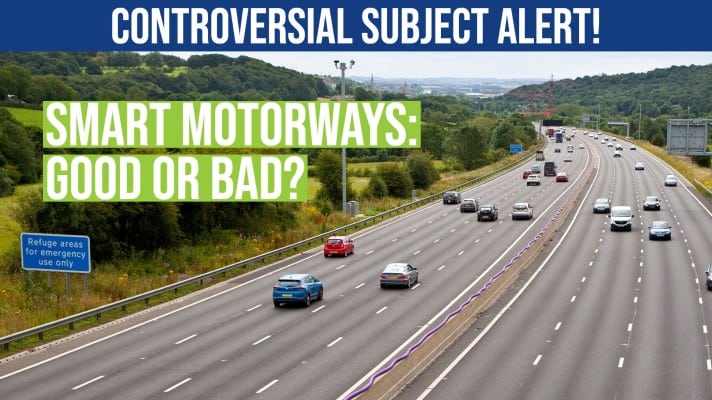Controversial Subject Alert! Smart Motorways: Good or Bad?
The first smart motorway was introduced all the way back in 2006 when it was initially trialled on the M42, our neck of the woods! We can see that… beautiful road… right from our office! Did you know they’ve been around for that long? There are 3 types of smart motorways in the operation in England.
Dynamic Hard Shoulder Running (DHSR)
You’ve probably seen the Dynamic Hard Shoulder Running smart motorway schemes before as they’re everywhere; the DHSR smart motorway operates on the M42, M1, M6, M4, and M5. These motorways have a solid white line to differentiate the hard shoulder from the normal carriageway. If there is a red cross displayed on the sign above the lane, you should move out of the lane and not drive in it. Failing to do so can result in fines of £100 and points on your licence.
Controlled Motorway
These motorways have 3 or more lanes but keep the traditional hard shoulder, which is only to be used in emergencies. Speed limits and lane closure symbols are shown in the overhead gantry signs. There is a concern as to changing speed limits on these signs and giving drivers enough time to slow down. There is a short space of leeway for drivers to slow down, but drivers should remain vigilant and alert for any change in the overhead signs.
All Lane Running (ALR)
The All Lane Running smart motorway uses the hard shoulder as a permanent “live” running lane for traffic. The ALR scheme was first trialled on the M25 and all running lanes have broken white lines. This essentially means that there is no hard shoulder. The left-hand lane, typically where the hard shoulder would be, is closed only in an emergency.
What should you do in an emergency on this kind of motorway, with no reliable hard shoulder to pull over on to? You can find the National Highways advice here, but is this the best advice? Is this the best chance you have of staying safe with no hard shoulder?
There is essentially no hard shoulder on, really, any of these motorways. Due to this, there is a debate around whether any of these “smart” motorways are safe. What do you think? Would you rather stick to the old motorways of average intelligence? Let’s delve a little deeper.
Do They Help Air Pollution?
A strange connection? Potentially not! In heavily congested areas, it’s not surprising that air pollution would skyrocket. That’s why, at the end of April 2021, on the M1 between junction 33 and junction 34 an indefinite 60mph speed restriction was introduced. This is designed to address and combat the dangerously high air pollution in the area. Previously, this has worked to reduce air pollution on another section of the M1 (junction 28 to 35a between Sheffield and Rotherham) in 2017.
According to an article by Express in May 2021, they reported that over 15,000 tonnes of extra carbon emissions were recorded one year after a section of smart motorway was opened on the M3 in Surrey. This was two thirds higher than the initial forecast. Highways England have linked this to an increase in Heavy Goods Vehicles (HGVs) using the road. The director of Transport Action Network, Chris Toss, warned that smart motorways would create more traffic, in turn increasing emissions. Do you know what would ease air pollution on busy roads? An electric car, of course. If you want to reduce your footprint whilst sitting in traffic, check out how going electric through our salary sacrifice scheme can save your wallet and the planet.
Do They Help Congestion?
Smart motorways are designed to control the flow of traffic and reduce congestion in the area. They use a system called Active Traffic Management (ATM), which is a method of increasing the peak capacity of roads and smoothing traffic flows on busy major highways. This works by using methods such as variable speed limits and using the hard shoulder as a lane. However, do roads like this actually reduce congestion? Or do they invite more drivers on the road? According to a Highways England spokesperson, smart motorways have improved journey reliability by 22%, so take that how you will.
Do Smart Motorways Reduce Accidents?
Whilst smart motorways are stated as the safest roads, the Department for Transport’s Smart Motorway Safety Evidence Stocktake and Action Plan states that the rate of fatal casualties is lower, but the rate of slight casualties and serious casualties are higher. (Casualties referring to injuries, not deaths). There were 63 fatalities recorded between 2015 and 2019 on smart motorways. Compared to conventional motorways, where there were 368 fatalities, smart motorways seem like a great solution to reduce accidents, right?
Our findings show that the Miles of Road to Death ratio is very slightly higher on smart motorways than normal motorways.
To look in terms of deaths per mile of road, you would find that on 345 miles of smart motorway, there were 63 deaths between 2015 and 2019. This gives a ratio of 0.18 deaths per mile of smart motorway. This is higher than normal motorways (with 2,300 miles in total) saw 386 deaths in the same time period – a ratio of 0.16 deaths per mile of motorway. Although the difference is small, it’s hard to ignore the obvious safety issues with smart motorways, stemming from the removal of the conventional hard shoulder.
The rollout of smart motorways has been suspended until at least 2025, which is in response to safety concerns from MPs and motoring groups. We have said more than enough about smart motorways in this piece, but the nation is still divided. We want to know what you think about them. Get in touch below!
Tags : acicidents, all lane running. air pollution, congestion, controlled motorway, do smart motorways reduce accidents, dynamic hard shoulder running, smart motorways

